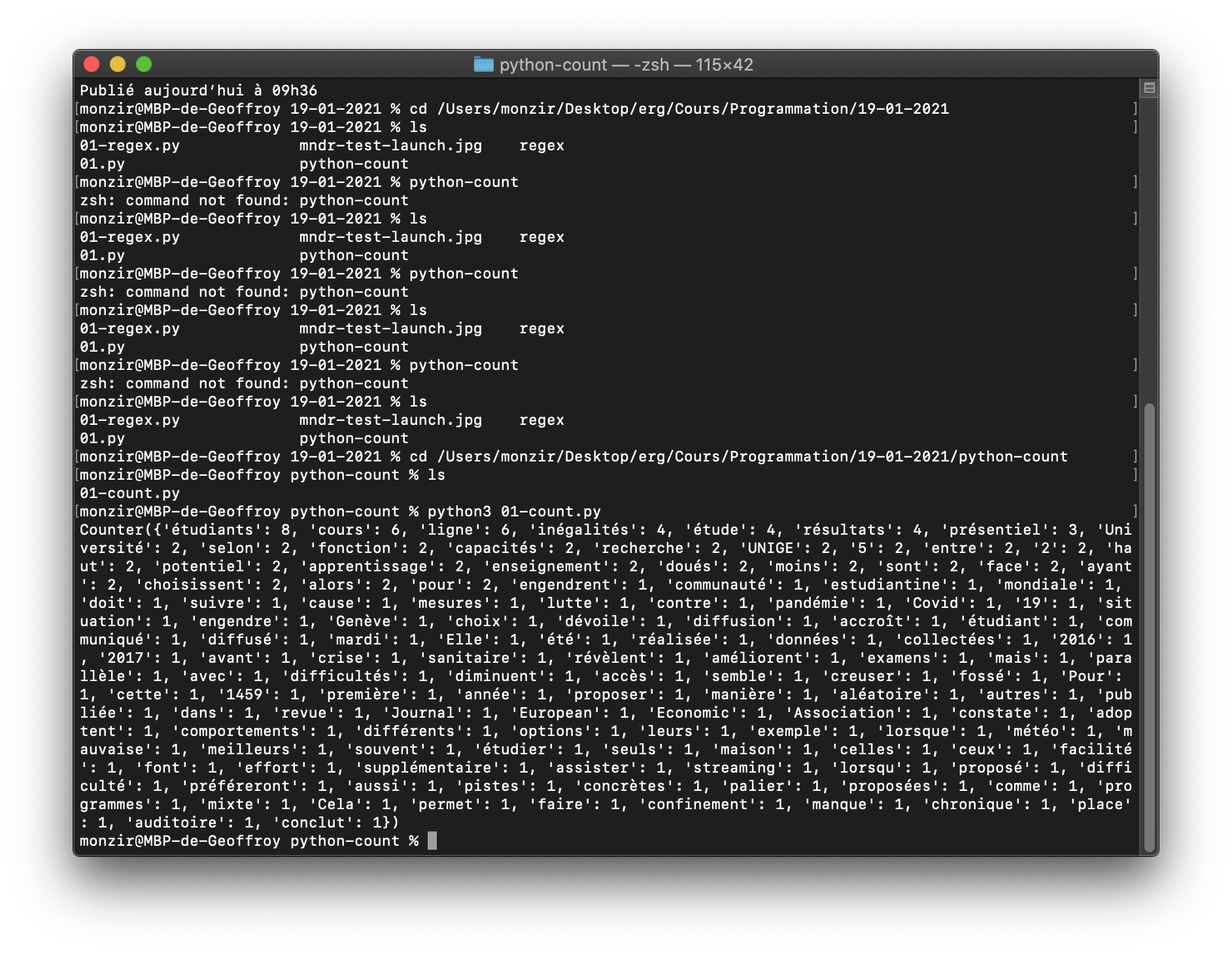Différences entre les versions de « Mondher »
| Ligne 343 : | Ligne 343 : | ||
[[Fichier:Mndr-python-count-1.jpg]] | [[Fichier:Mndr-python-count-1.jpg]] | ||
<br> | <br> | ||
| − | |||
| − | |||
| − | |||
| − | |||
| − | |||
| − | |||
| − | |||
| − | |||
| − | |||
| − | |||
| − | |||
| − | |||
| − | |||
| − | |||
| − | |||
| − | |||
| − | |||
| − | |||
| − | |||
| − | |||
| − | |||
| − | |||
| − | |||
| − | |||
| − | |||
| − | |||
| − | |||
| − | |||
| − | |||
| − | |||
| − | |||
| − | |||
| − | |||
| − | |||
| − | |||
| − | |||
| − | |||
| − | |||
| − | |||
| − | |||
| − | |||
| − | |||
| − | |||
| − | |||
| − | |||
| − | |||
| − | |||
| − | |||
| − | |||
| − | |||
Version du 11 mars 2021 à 12:08
Hello !
travail en cours : ranking de termes médiatiques
Quoi ?
Une page web affiche un ranking en temps réel des termes utilisés dans les articles d'une sélection de médias de Suisse romande.
Pour une sélection de sites internets, un classement des X mots les plus utilisés est présenté sous la forme d'un tableau de type indice boursier, avec les gains et les pertes en pourcentages de chaque terme.
Comment ?
1/ définir les sources
Une sélection de quatorze journaux suisse-romands a été retenue. Cette sélection contient la totalité des quotidiens de la partie francophone de Suisse; chaque canton est représenté. Les critères de sélection sont les suivants : le journal doit être un quotidien suisse-romand, il doit être francophone, il doit traiter de l’actualité internationale, nationale et cantonale et il doit diffuser ses informations sur un site internet et/ou une application entre autre.
Sélection:
· 24 heures (Canton de Vaud)
· Tribune de Genève (Canton de Genève)
· Le Temps (Canton de Genève)
· La Liberté (Canton de Fribourg)
· La Gruyère (Canton de Fribourg)
· Le Nouvelliste (Canton du Valais)
· Arc Info (Canton de Neuchâtel)
· Le Journal du Jura (partie francophone du Canton de Berne)
· Le Quotidien jurassien (Canton du Jura)
· La Côte (Région lémanique)
· La Région (Région Nord-vaudoise)
· Le Courrier (Romandie)
· Le Matin (Romandie)
· 20 Minutes (Romandie)
2/ diagramme de la base de données
Une structure de base de données a été créée sur sur phpMyAdmin. La base de données est structurée en catégories et sous-catégories distinctes. Toute informations récoltée est triée et classée dans la catégorie adéquate. Il y a trois catégories et trois sous-catégories :
—La catégorie article : elle regroupe l’ID de la catégorie article, le titre de l’article, son header, son corps de texte, sa date de publication, sa date de modification (s’il y en a une), son url, sa source
—— La sous-catégorie source : elle regroupe l’ID de la source , son nom et son url
—La catégorie article_aut·eur·ice: elle regroupe l’ID de la catégorie aut·eur·rice·s, l’ID de la sous-catégorie aut·eur·ice·s et l’ID des articles par aut·eur·rice·s
—— La sous-catégorie aut·eur·ice regroupe l’ID de chaque aut·eur·rice·s, son nom, son prénom et une courte bio (s’il y’en a une)
—La catégorie article_mots: elle regroupe l’ID de la catégorie article_mots, l’ID de chaque article, l’ID de la sous-catégorie mots
—— La sous-catégorie mots : elle regroupe l’ID de chaque mot retenu et classé, le mot en question et la valeur de sa fréquence d’apparition
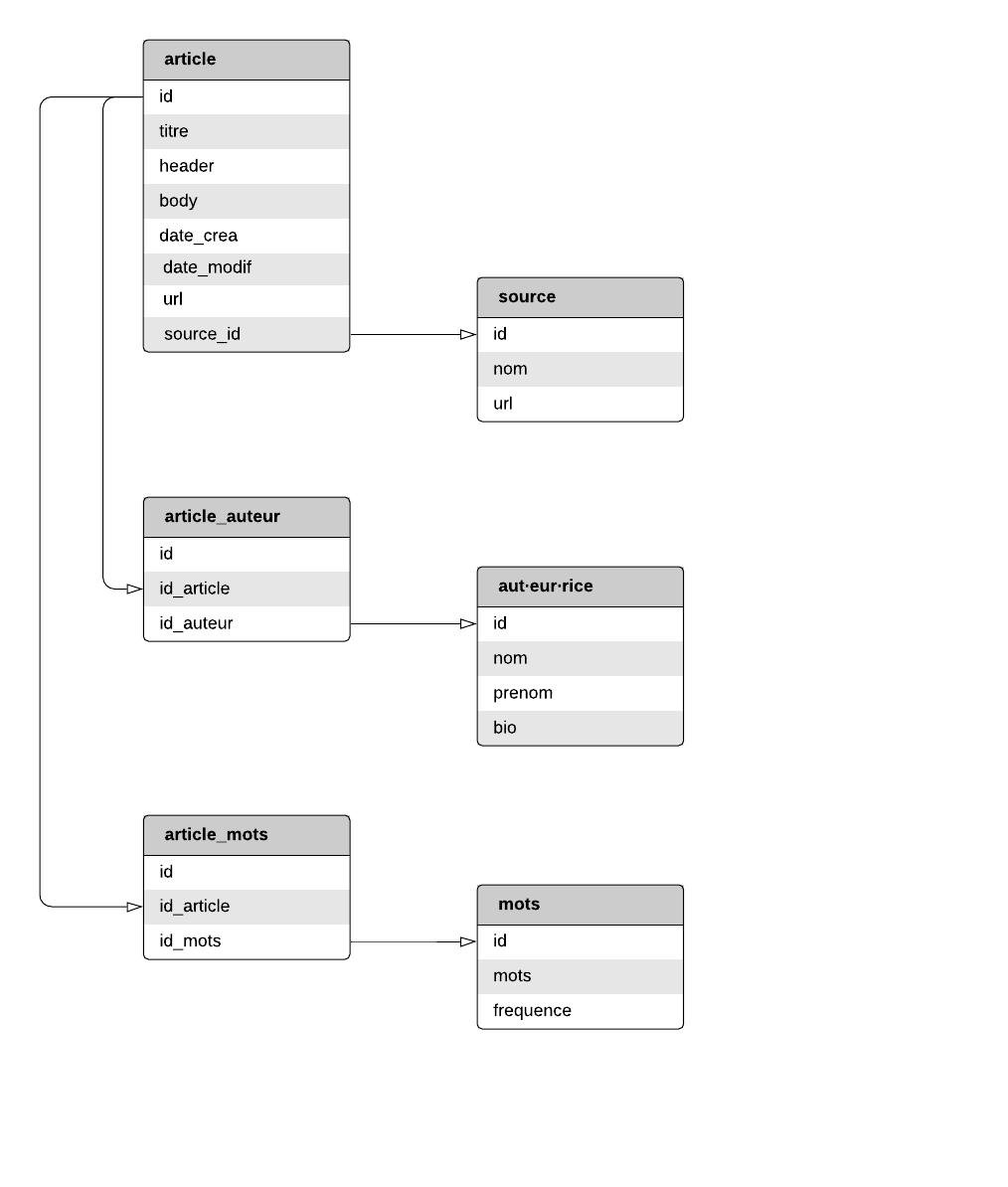 Schéma de la structure de la base de données
Schéma de la structure de la base de données
-- phpMyAdmin SQL Dump
-- version 4.9.5
-- https://www.phpmyadmin.net/
--
-- Host: localhost:8889
-- Generation Time: Feb 25, 2021 at 08:43 AM
-- Server version: 5.7.30
-- PHP Version: 7.4.9
SET SQL_MODE = "NO_AUTO_VALUE_ON_ZERO";
SET time_zone = "+00:00";
/*!40101 SET @OLD_CHARACTER_SET_CLIENT=@@CHARACTER_SET_CLIENT */;
/*!40101 SET @OLD_CHARACTER_SET_RESULTS=@@CHARACTER_SET_RESULTS */;
/*!40101 SET @OLD_COLLATION_CONNECTION=@@COLLATION_CONNECTION */;
/*!40101 SET NAMES utf8mb4 */;
--
-- Database: `indice_popularité_termes`
--
-- --------------------------------------------------------
--
-- Table structure for table `article`
--
CREATE TABLE `article` (
`id` int(10) UNSIGNED NOT NULL,
`titre` text NOT NULL,
`header` text NOT NULL,
`body` text NOT NULL,
`date_crea` datetime NOT NULL,
`date_modif` datetime NOT NULL,
`url` text NOT NULL,
`source_id` int(10) UNSIGNED NOT NULL
) ENGINE=InnoDB DEFAULT CHARSET=utf8;
--
-- Dumping data for table `article`
--
INSERT INTO `article` (`id`, `titre`, `header`, `body`, `date_crea`, `date_modif`, `url`, `source_id`) VALUES
(1, '1', '2', '3', '2020-10-07 12:11:40', '2020-10-14 12:11:40', '4', 4);
-- --------------------------------------------------------
--
-- Table structure for table `article_auteur`
--
CREATE TABLE `article_auteur` (
`id` int(10) UNSIGNED NOT NULL,
`id_article` int(10) UNSIGNED NOT NULL,
`id_auteurice` int(10) UNSIGNED NOT NULL
) ENGINE=InnoDB DEFAULT CHARSET=utf8;
-- --------------------------------------------------------
--
-- Table structure for table `article_mots`
--
CREATE TABLE `article_mots` (
`id` int(10) UNSIGNED NOT NULL,
`id_article` int(11) NOT NULL,
`id_mots` int(11) NOT NULL
) ENGINE=InnoDB DEFAULT CHARSET=utf8;
-- --------------------------------------------------------
--
-- Table structure for table `aut-eur-rice`
--
CREATE TABLE `aut-eur-rice` (
`id` int(10) UNSIGNED NOT NULL,
`nom` text NOT NULL,
`prénom` text NOT NULL,
`bio` text NOT NULL
) ENGINE=InnoDB DEFAULT CHARSET=utf8;
-- --------------------------------------------------------
--
-- Table structure for table `mots`
--
CREATE TABLE `mots` (
`id` int(10) UNSIGNED NOT NULL,
`mots` text NOT NULL,
`fréquence` int(11) NOT NULL
) ENGINE=InnoDB DEFAULT CHARSET=utf8;
-- --------------------------------------------------------
--
-- Table structure for table `source`
--
CREATE TABLE `source` (
`id` int(10) UNSIGNED NOT NULL,
`nom` text NOT NULL,
`url` text NOT NULL
) ENGINE=InnoDB DEFAULT CHARSET=utf8;
--
-- Indexes for dumped tables
--
--
-- Indexes for table `article`
--
ALTER TABLE `article`
ADD PRIMARY KEY (`id`);
--
-- Indexes for table `article_auteur`
--
ALTER TABLE `article_auteur`
ADD PRIMARY KEY (`id`);
--
-- Indexes for table `article_mots`
--
ALTER TABLE `article_mots`
ADD PRIMARY KEY (`id`);
--
-- Indexes for table `aut-eur-rice`
--
ALTER TABLE `aut-eur-rice`
ADD PRIMARY KEY (`id`);
--
-- Indexes for table `mots`
--
ALTER TABLE `mots`
ADD PRIMARY KEY (`id`);
--
-- Indexes for table `source`
--
ALTER TABLE `source`
ADD PRIMARY KEY (`id`);
--
-- AUTO_INCREMENT for dumped tables
--
--
-- AUTO_INCREMENT for table `article`
--
ALTER TABLE `article`
MODIFY `id` int(10) UNSIGNED NOT NULL AUTO_INCREMENT, AUTO_INCREMENT=2;
--
-- AUTO_INCREMENT for table `article_auteur`
--
ALTER TABLE `article_auteur`
MODIFY `id` int(10) UNSIGNED NOT NULL AUTO_INCREMENT;
--
-- AUTO_INCREMENT for table `article_mots`
--
ALTER TABLE `article_mots`
MODIFY `id` int(10) UNSIGNED NOT NULL AUTO_INCREMENT;
--
-- AUTO_INCREMENT for table `aut-eur-rice`
--
ALTER TABLE `aut-eur-rice`
MODIFY `id` int(10) UNSIGNED NOT NULL AUTO_INCREMENT;
--
-- AUTO_INCREMENT for table `mots`
--
ALTER TABLE `mots`
MODIFY `id` int(10) UNSIGNED NOT NULL AUTO_INCREMENT;
--
-- AUTO_INCREMENT for table `source`
--
ALTER TABLE `source`
MODIFY `id` int(10) UNSIGNED NOT NULL AUTO_INCREMENT;
/*!40101 SET CHARACTER_SET_CLIENT=@OLD_CHARACTER_SET_CLIENT */;
/*!40101 SET CHARACTER_SET_RESULTS=@OLD_CHARACTER_SET_RESULTS */;
/*!40101 SET COLLATION_CONNECTION=@OLD_COLLATION_CONNECTION */;
3/ écrire un programme (en python) pour récolter et stocker les informations contenues dans certains sélecteurs css :
1. repère et pointe les sélecteurs css qui contiennent les informations nécessaires
2. initialise un objet "navigateur" pour se connecter au site web à l'aide de la librairie mechanize
3. contourne une éventuelle demande de certificat de sécurité ssl pour accéder au contenu de la page
4. extrait les données de la page web contenues dans les sélecteurs css ciblés
5. lit les données
6. encode les données en utf-8
7. récupère le contenu des sélecteurs css et les traduit en expressions xpath
8. print les informations
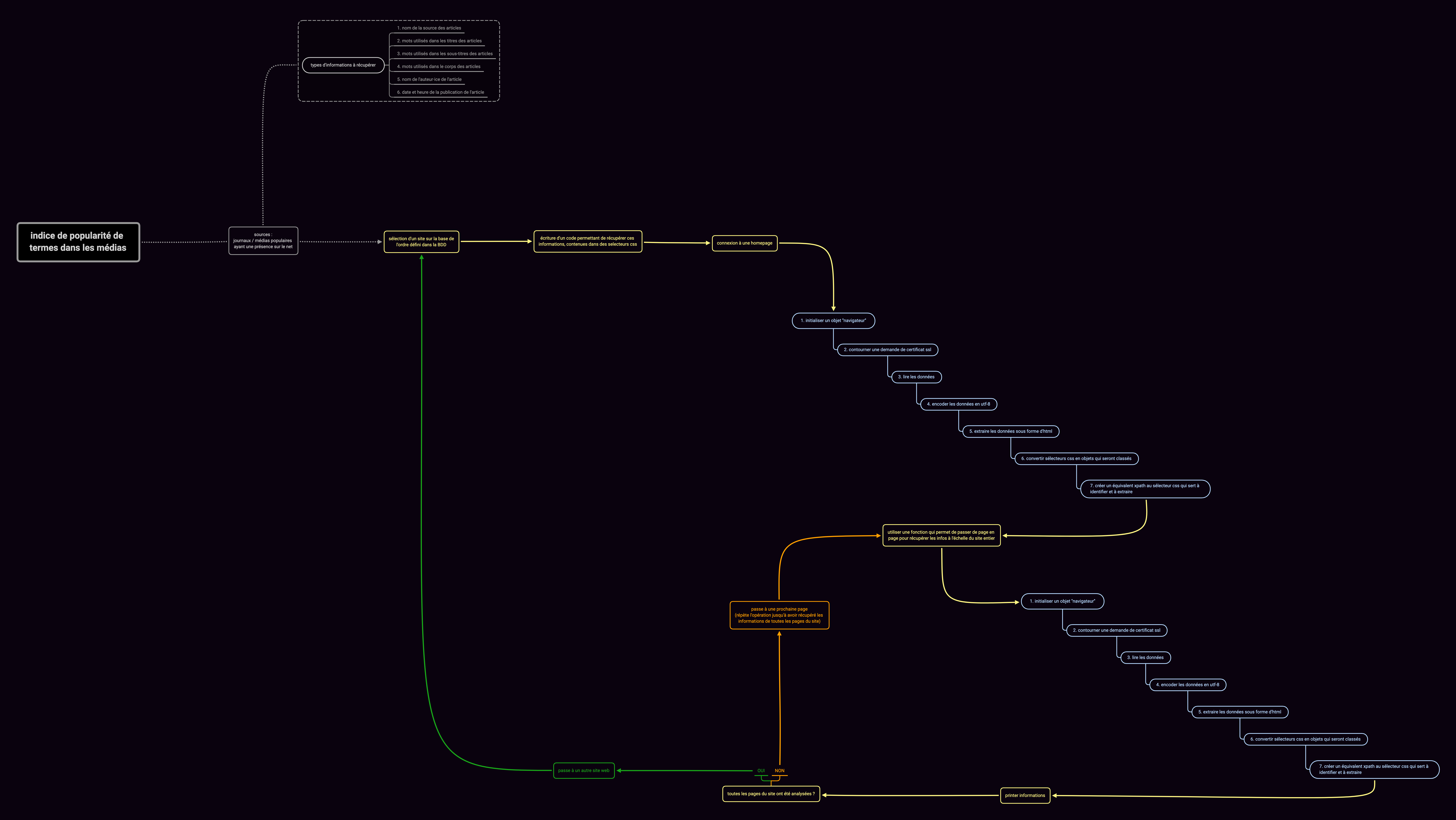 Schéma du processus
Schéma du processus
Test du programme
Page cible
https://www.24heures.ch/les-cours-en-ligne-engendrent-des-inegalites-800936194846
Code
<syntaxhighlight lang="python">
- un programme qui récupère les données contenues dans les sélecteurs css suivants à partir d'une page d'article de 24heures.ch
- article h1, article h2, article h3, article p et article time
import mechanize
import lxml.html as lh
import cssselect
import ssl
- initialisation d'un objet "navigateur" avec la librairie mechanize
br = mechanize.Browser()
br.addheaders = [('User-agent', 'Mozilla/5.0 (X11; U; Linux i686; en-US; rv:1.9.0.1) Gecko/2008071615 Fedora/3.0.1-1.fc9 Firefox/3.0.1')]
br.set_handle_robots(False)
- fin de la configuration de mechanize
try:
_create_unverified_https_context = ssl._create_unverified_context
except AttributeError:
# Legacy Python that doesn't verify HTTPS certificates by default pass
else:
# Handle target environment that doesn't support HTTPS verification ssl._create_default_https_context = _create_unverified_https_context
data = br.open('https://www.24heures.ch/les-cours-en-ligne-engendrent-des-inegalites-800936194846', timeout=10.0)
rawdata = data.read()
unicode = rawdata.decode('utf-8', 'ignore')
src = lh.fromstring(unicode)
- on convertit un sélecteur css en objets de type "cssselector"
selecteurs = cssselect.parse('article h1, article h2, article h3, article p, article time')
for selecteur in selecteurs:
chemin_xpath = cssselect.HTMLTranslator().selector_to_xpath(selecteur, translate_pseudo_elements=True)
resultats = src.xpath(chemin_xpath)
for resultat in resultats:
print(resultat.text_content())
Lancement du programme dans le terminal

Tentative de tri du texte avec des regex et de comptage de l'occurrence des mots
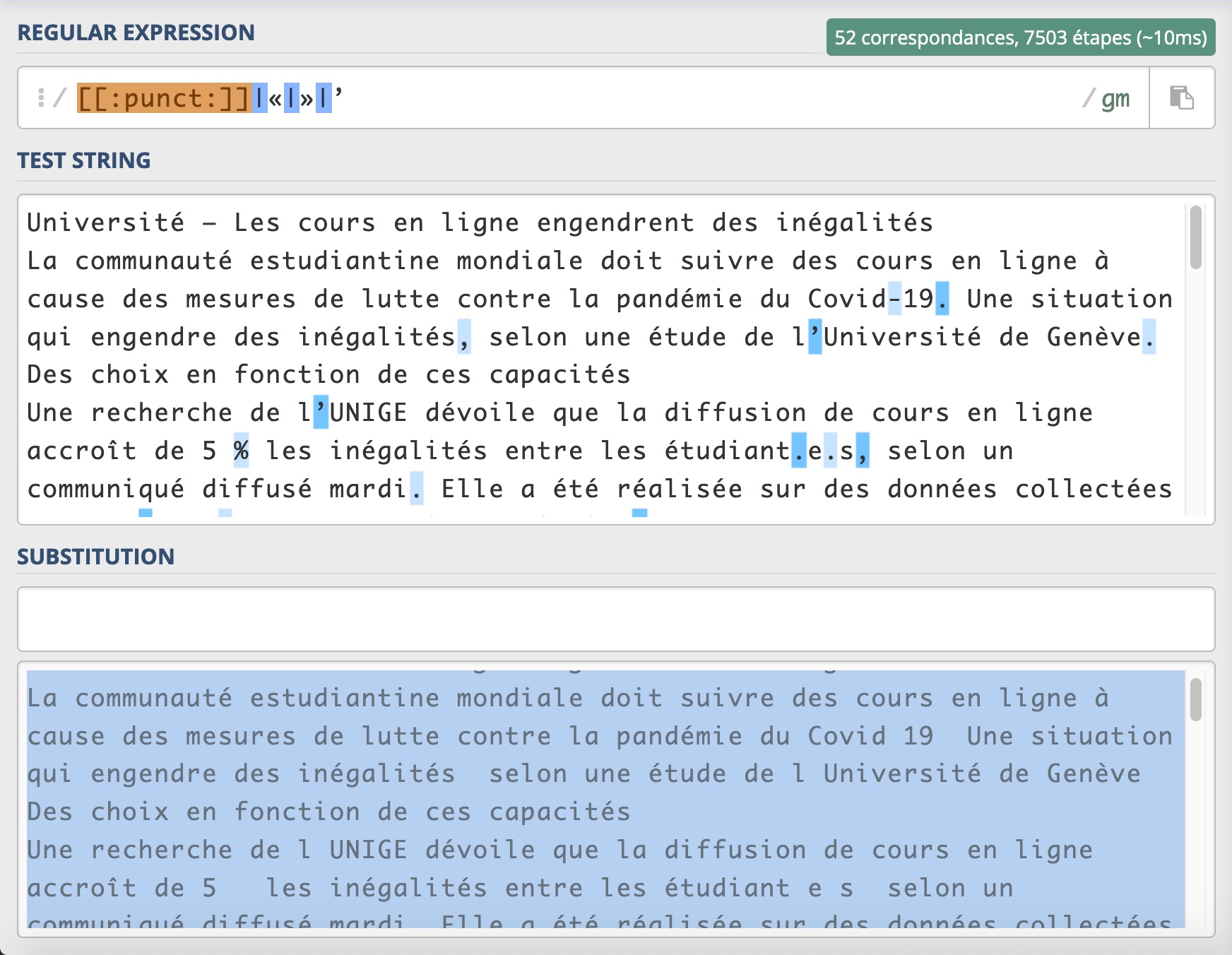
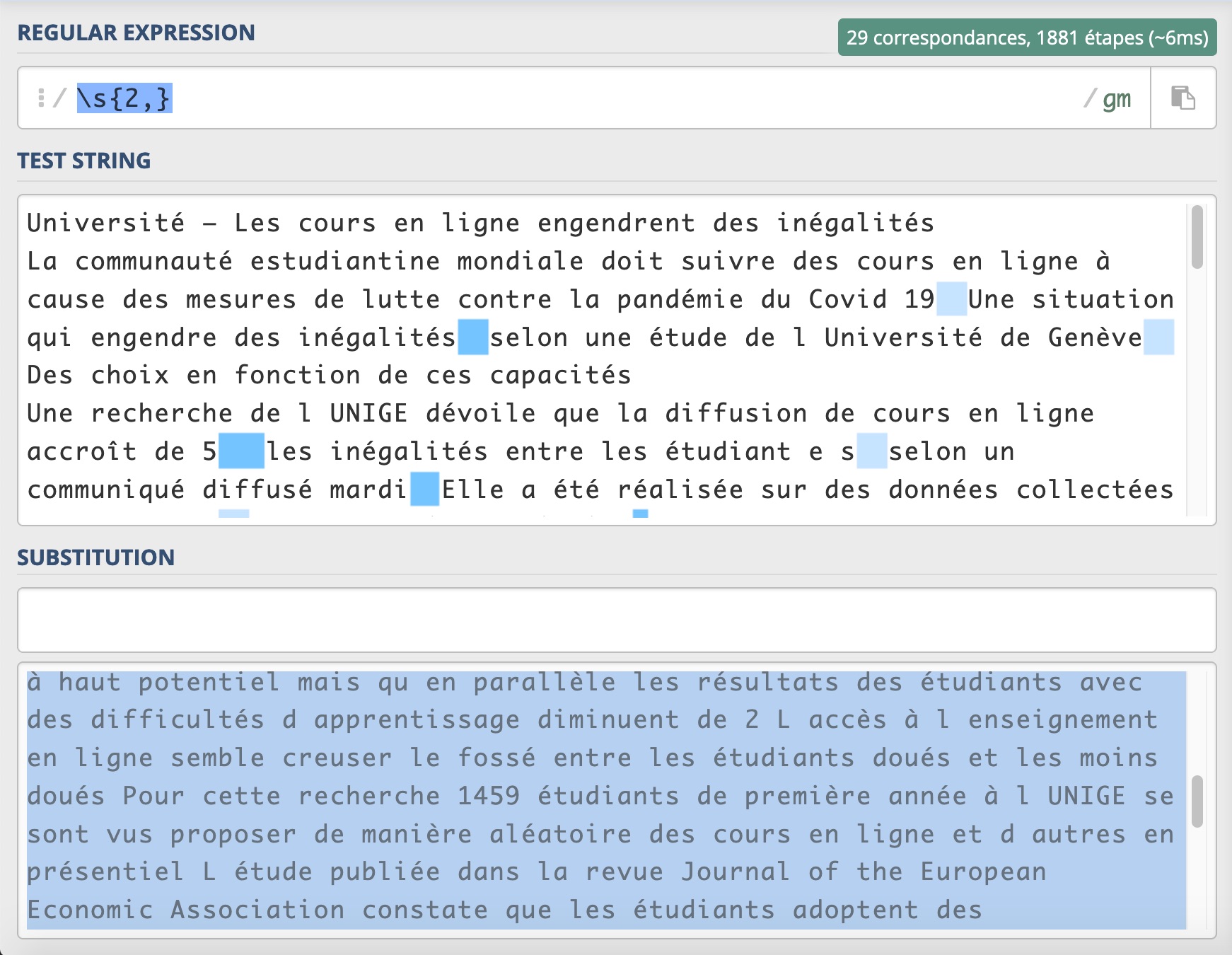
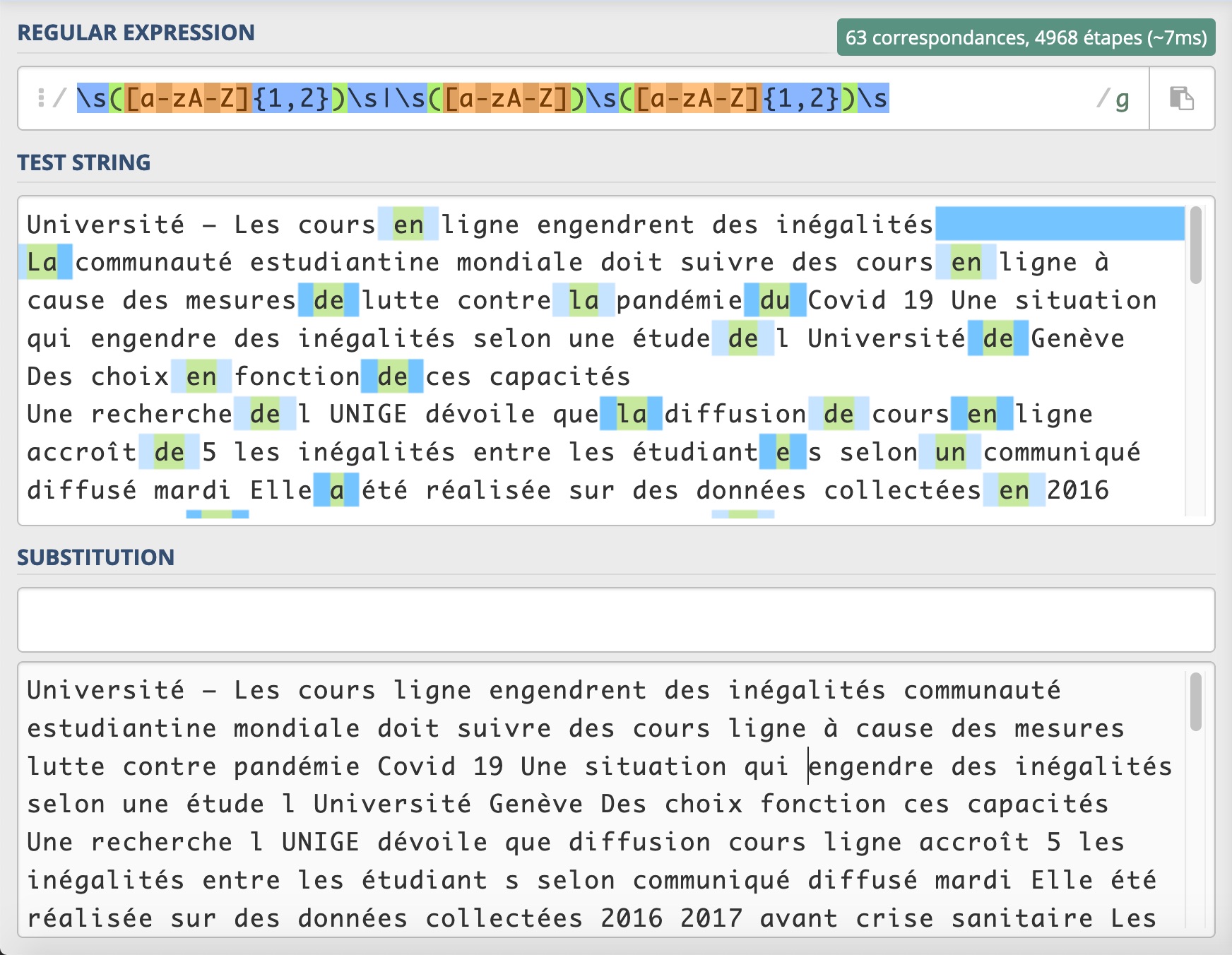
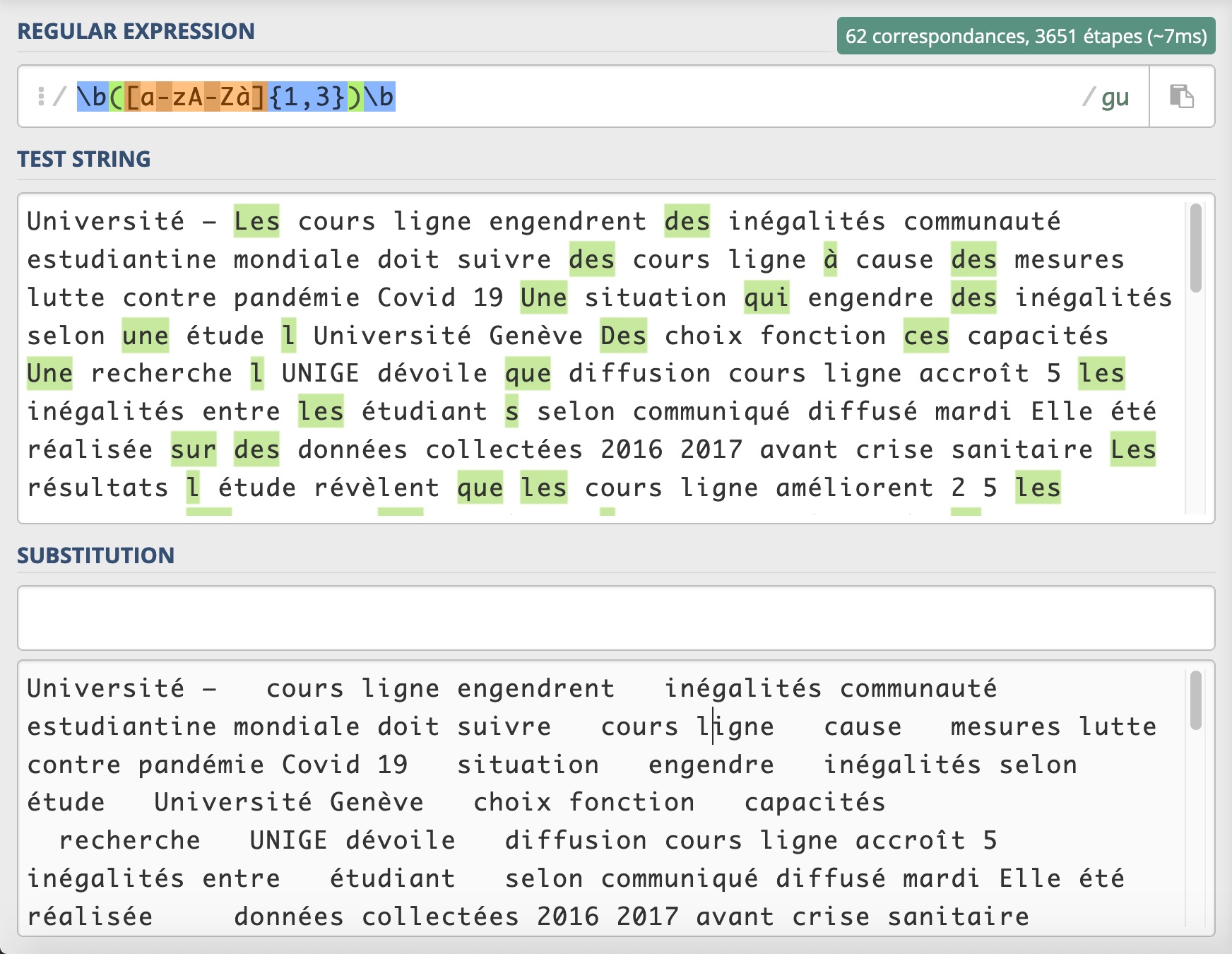
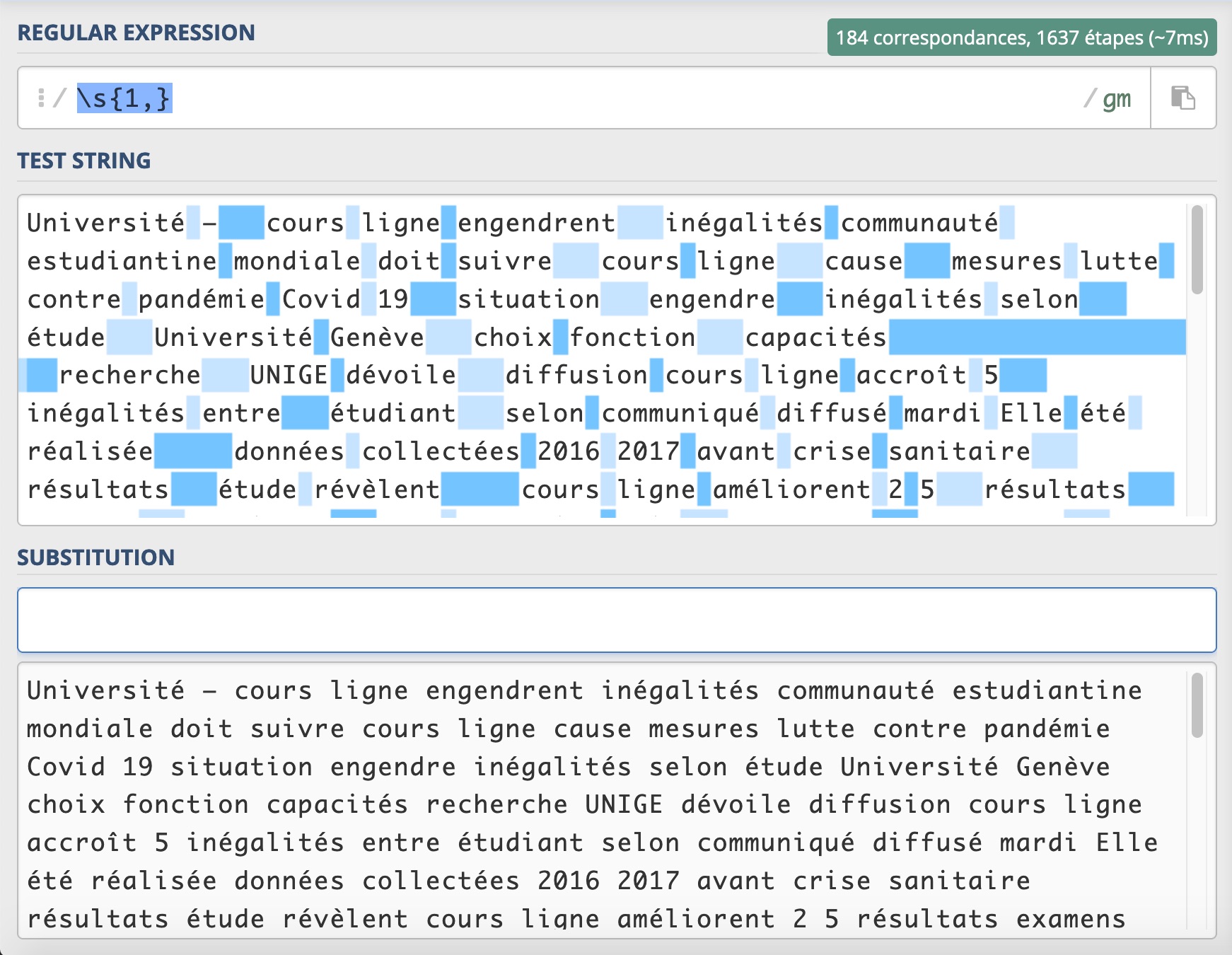
Le résultat est pas trop mal. J'aimerais maintenant comprendre faire pour garder des mots composés comme "en ligne" et aussi comment rendre cette opération plus efficace et l'inclure dans le programme dans Python..
